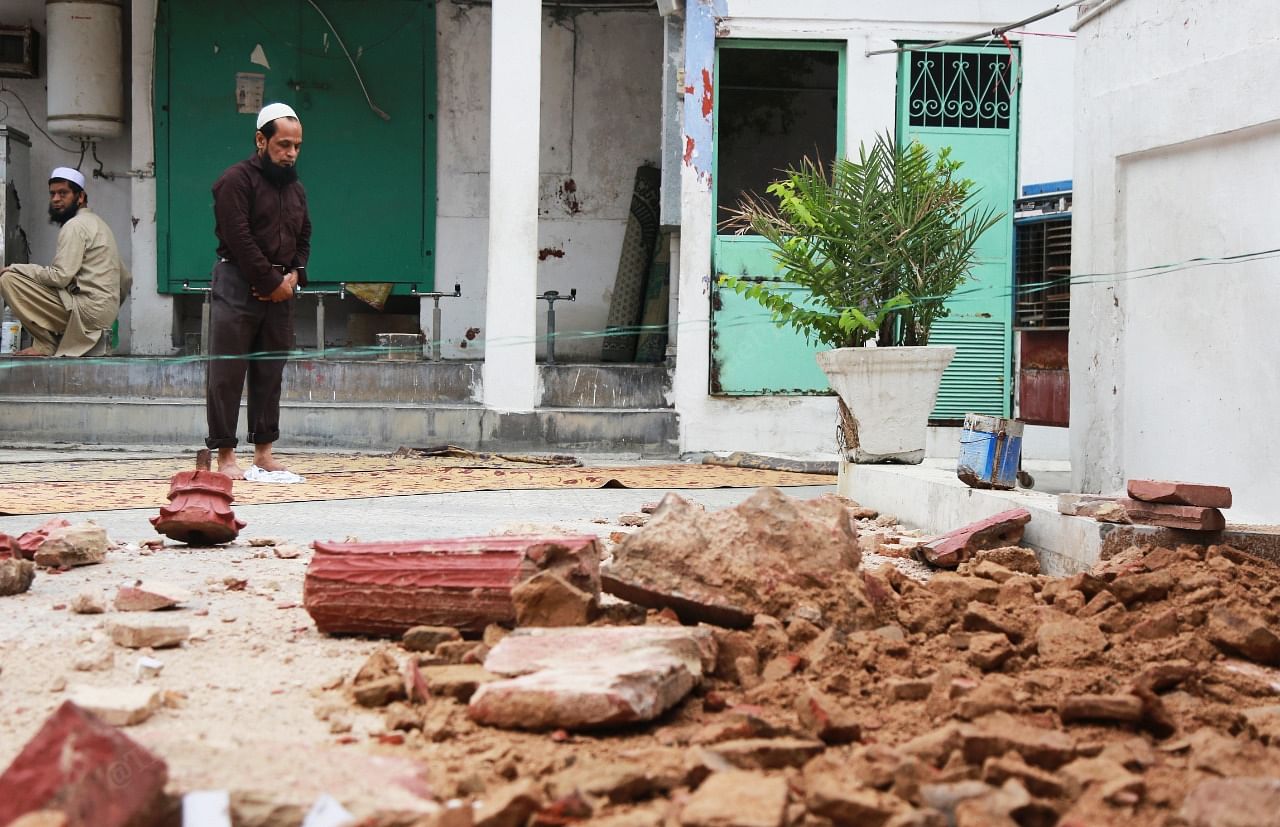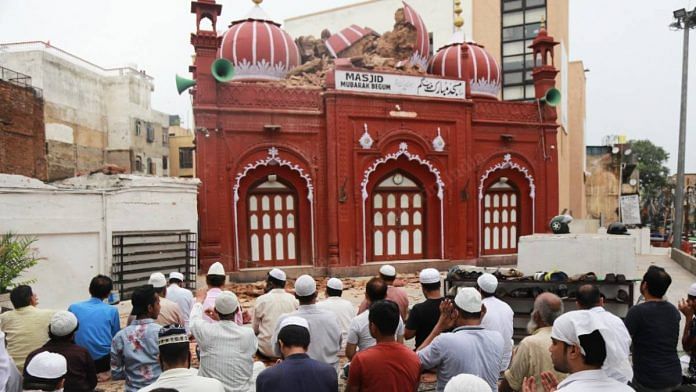New Delhi: The main dome of Delhi’s 200-year-old Mubarak Begum Masjid came crashing down early on Sunday after heavy rains lashed the national capital. Situated in the middle of Hauz Qazi Chowk in Old Delhi, the earthen-red mosque with green and white arches and carvings had stood tall since 1823.
Around 6:45 am, Mohammed Zahid, the muezzin, heard a loud sound. “Before I could understand anything, I saw that the masjid’s dome had collapsed,” said Zahid, who has been serving the mosque since 2004. According to the sadar (president) of the mosque, Syed Zafar Ali, there was one person offering prayers inside the main structure.
“Namaz of Fajr (morning prayer) had just concluded, but fortunately many people had gone back home. There was only one person who was inside the masjid who came running towards the courtyard as he heard the loud noise,” Zafar Ali told ThePrint.
Ali added that the dome of the mosque was probably struck by lightning, which caused the collapse. “It was probably due to lightning as the masjid which stood there for more than 200 years, could not simply collapse due to the rain,” Ali said.

According to historian Rana Safvi, the chronogram on the masjid yields the date AH 1238, which indicates the mosque was built during AD 1822–23.
Though pained by the damage to a historic monument, Islamuddin, the general secretary of the mosque, said he was grateful that no one got hurt.
“This is a big haadsa (mishap), but thanks to God, no one got injured. Usually 50-60 people come everyday to offer prayers in the mosque during the Namaz of Fajr,” Islamuddin, whose forefathers had served the mosque for the past 20 years, told ThePrint.
Though a historical building, the mosque falls under the Delhi Waqf Board and not the Archaeological Survey of India (ASI).
Safvi said this was perhaps because the mosque was not registered with the ASI.
“There are certain rules and regulations about which monuments fall under the jurisdiction of ASI … only few mosques like Sunehri Masjid and Jami Masjid come under our jurisdiction,” said an ASI official on the condition of anonymity.
Himal Akhtar, member of the Delhi Waqf Board, told ThePrint that the board constituted a team to look into the matter. “Our technical team is inspecting the site. As soon as we get a report, we’ll proceed further with appropriate action,” Akhtar said.
Also read: 174 monuments & sites in Delhi declared monuments of national importance: Prahlad Patel
A unique mosque
A small pair of steps from a usually crowded street in Chawri Bazar leads to an open courtyard where the red-sandstone Masjid with three tombs is situated.
Historian Safvi, who authored ‘Shahjahanabad: The Living City of Old Delhi’, tells ThePrint that the mosque was special because it was among the very few to be made by women in India at the time.
“The masjid is an important cultural and historical symbol as it was built by a woman — and men still come to pray here,” she said.
“The white marble tablet above the central arch of the masjid reads that Mubarak Begum built this mosque which is superior to the arched sky, and it has been compared to Jerusalem,” she said.
Mubarak Begum was a dancing girl from Pune who came to Delhi and converted to Islam. She later married Sir David Ochterlony, the first British resident of Delhi. Ochterlony had commanded one of four columns under General Hastings that defeated Nepal’s Kaji Amar Singh Thapa’s Gurka army in 1815. He also ratified the Treaty of Saugauli that settled the borders with Nepal.
After Ochterlony’s death, Mubarak Begum, married a Mughal soldier Wilayat Khan and fought alongside him against the British in the rebellion of 1857.
Also read: Temperature checks, sanitisers, social distancing — Delhi monuments welcome back visitors







Progressive and women emporment sab thik hai ye to bata dete ki isko “Rundi ki masjid” kyun kahte hai..
https://mobile.twitter.com/DalrympleWill/status/1284913803923259398
Dancing girl sirf nritya thodi karte the. R ne banaya toh r ki masjid. Par ek baat hai tab visesh samuday utna khula dimag tha ki isse hone diya ab ke hote toh bisphot hote.